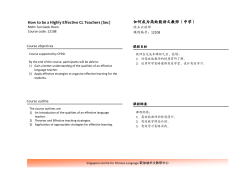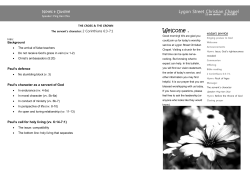
Sample Exam 1 Solutions Physics 132
Sample Exam 1 Solutions Physics 132 1. Compute the size of the charge necessary for two spheres separated by 1m to be attracted with a force of 1 N. How many electrons is this charge? Let us assume that the charges are equal and opposite. You would need to be told this.... F= q1q2 q2 = 4 πε0 r 2 4 πε0 r 2 q = 4 πε0 r 2 F = 4 π ⋅ 8.85 ×10−12 ⋅12 ⋅1N q = (# electrons) ⋅ (1.6 ×10−19 C / electron) (# electrons) = q 4 π ⋅ 8.85 ×10−12 ⋅12 ⋅1N = (1.6 ×10−19 C / electron) (1.6 ×10−19 C / electron) 2. What is the electric field on the surface of a Uranium nucleus? Take the nucleus to be a uniformly charged sphere with a charge of +92e and radius 10 fm. q (92 × 1.6 × 10−1 9 ) E= = 4πε 0 r2 4π ⋅ 8.85 × 10−1 2 ⋅ (10 × 10 −1 5)2 3. How may electrons pass per second if a current of 10 A flows in a wire? Δq No. of electrons 1.6 × 10 −1 9C = ⋅ Δt sec electron No. of electrons i 10A = = −1 9 1.6 × 10 C 1.6 × 10 −1 9C sec electron electron i= 4. A proton and an electron are separated by a distance of 1Angstrom. What is the dipole moment of this system? What torque would this dipole experience if it was placed in a uniform electric field of 1000 N/C at an angle of 30 degrees with respect to the field? p = qd = 1.6 × 10−1 9 ⋅1× 10 −1 0m = 1.6 × 10 −2 9Cm τ = pE sinθ = 1.6 × 10 −2 9Cm ⋅1000N / C ⋅ sin30° 5. The electric field at a certain point is 100 N/C. What force would a 10 C charge feel at that point? F = qE = 10 C ⋅100N / C = 1000N 6. What is the electric field inside a conductor and why? E equals zero. If the field is not zero, the charges rearranges themselves to shield the field. 7. A cube encloses an electric dipole with p = 10x10-9 Cm. What is the net flux through the surface of the cube? You may assume that the dipole is at the center. The net flux through a closed surface is proportional to the enclosed charge. The net charge of an electric dipole is zero so... q ϕ = ∫ E ⋅ dA = enc = 0 ε0 8. A point charge +q is placed inside a conducting spherical shell with inner radius a and outer radius b. What is the total charge on the inner surface and why? What is the charge on the outer surface and why? Sketch the field as a function of r. Since the electric field in a conductor is zero, a Gaussian surface that is in the range a<r<b must enclose zero net charge. This implies that the charge on the inner surface of the conductor is -q. For the conductor to be electrically neutral, the outer surface must be +q. For r<a, only the point charge is enclosed by a Gaussian surface, so the field looks like a point charge at the origin. For a<r<b, the field is zero. For r>b, the field looks like a point charge at the origin. 9. A closed cylindrical surface is placed in an electric field that points along its axis. The cylinder is 1 m long and has a radius of 0.3 m. The field has a strength of 10 N/C on one of the endcaps and has a strength of 30 N/C on the other. What is the net electric flux and what net charge is contained in the surface? 30N/C 10N/C ϕ net = E Left ⋅ Area − E Right ⋅ Area = 30N / C ⋅ π (0.3m) 2 −10N / C ⋅ π (0.3m) 2 qenc = 20N / C ⋅ π (0.3m) 2 = ε0 ϕ net 10. An electron is placed at the center of a cube. What is the electric flux through one side of the cube? Gauss’ Law tells us that the total net flux through a closed surface is proportional to the net charge enclosed. In this case, by symmetry, we know that the flux through each side of the cube is the same, so the flux through one side is ϕ= 1 e ⋅ 6 ε0 Problems. 1. Charges +q, +2q and +3q are placed at the edges of an equilateral triangle with side a. The +q is placed on the origin, the +2q is at x=a, y=0, and the +3q is placed at the remaining corner q3 E2 E1 x q1 q2 E3 a) Compute the electric field vector for a point at the center of the triangle. First, write all the positions of all the charges and the field point. q1: ( 0, 0 ) q2: ( a, 0 ) q3: ( a/2 , a sin 60) field at: (a/2, (a tan 30)/2) Now write all the r vector information a a − 0) 2 + ( tan 30 − 0 ) 2 = 2 2 a a r1 = ( − 0 ) iˆ + ( tan 30 − 0) ˆj = ( 2 2 ( a ) iˆ + ( a tan 30) ˆj r1 2 rˆ1 = = 2 r1 a 2 a ( ) + ( tan 30) 2 2 2 r1 = ( a 2 a ) + ( tan 30) 2 2 2 a ˆ a ) i + ( tan 30 ) ˆj 2 2 ( a a a a − a ) 2 + ( tan 30 − 0) 2 = (− ) 2 + ( tan 30) 2 2 2 2 2 a a a a r2 = ( − a ) iˆ + ( tan 30 − 0) ˆj = (− ) iˆ + ( tan 30) ˆj 2 2 2 2 a a (− ) iˆ + ( tan 30) ˆj r2 2 2 rˆ2 = = r2 a 2 a (− ) + ( tan 30) 2 2 2 r2 = ( a a a a r3 = ( − ) 2 + ( tan 30 − asin60) 2 = ( tan 30 − asin60) 2 2 2 2 2 a a a a r3 = ( − ) iˆ + ( tan 30 − asin60) ˆj = ( tan 30 − asin60) ˆj 2 2 2 2 a ( tan 30 − asin60) ˆj r3 rˆ3 = = 2 = − ˆj r3 a ( tan 30 − asin60) 2 2 Now we can write the E fields.. E1 = q1 q ˆ ˆ 2 r1 = 2 r1 4 πε0 r1 4 πε0 r1 q2 2q ˆ ˆ E2 = 2 r2 = 2 r2 4 πε0 r2 4 πε0 r2 q3 3q ˆ ˆ E3 = 2 r3 = 2 r3 4 πε0 r3 4 πε0 r3 E = E1 + E 2 + E 3 b) What force would a charge -q experience at that point? F = −qE c) Make a sketch of the field. Field lines start at each positive charge and radiate outward while being repelled by other field lines.. 2. A ring of radius a with charge per unit length la lies in the x-y plane. A second ring with radius b lies in the same plane with charge per unit length lb. θ x dE θ a) Find an expression for the electric field due to the ring with radius a for a point at a distance z away from the x-y plane. We begin by setting up and calculating for the “a” ring. Ez = dE z = dE cosθ dE = r= a +z dq = λ a adϕ cos θ = ∫ dE z 0 dq 4πε 0 r 2 2 2π Ez = 2π 0 2 = λa a dϕ z ⋅ 2 2 a2 + z2 0 (a + z ) ∫ 4πε 2π ∫ 4πε 0 z a + z2 = 2 λa a z dϕ 2 2 3/2 0 (a + z ) λa a z 2ε 0 (a 2 + z 2 )3/2 b) What is the expression for the total field due to both rings at a point z above the x-y plane? The expression for the “b”ring is the same as for the “a” ring with b substituted for a. The total field is the sum of the two. Ez = λ a az λb b z 2 2 3 /2 + 2ε 0 (a + z ) 2ε 0 (b2 + z2 )3 / 2 c) What relationship between the charge densities would give zero field at the point z above the plane? Is there a point on the z axis that has zero field no matter what the charge densities are? Set the field to zero and solve for the charge density. E=0= λb = − λ a az λ b bz + 2 2 3 /2 2ε 0 (a + z ) 2ε 0 (b2 + z2 )3 / 2 λ a a (b 2 + z 2 )3/ 2 b(a2 + z2 )3 / 2 The field at the origin is zero no matter what the charge density. 3. A nonconducting sphere has a uniform charge density of 1 C / m3 and a radius of 0.1 m a) What is the total charge on the sphere? 4 qenc = ρ ⋅ π a3 3 b) What is the electric field at a distance of 1 m away from the sphere’s center. ∫ E ⋅ da = qencl ε0 E ⋅ 4π r 2 = ρ⋅ 4 3 a 3 ε0 ρ a3 E= 3ε 0 r 2 Now consider a Gaussian surface inside the sphere. Assume the Gaussian surface is a sphere of radius r where r is less than 0.1 m. c) What is the charge contained in the Gaussian surface? 4 qencl = ρ ⋅ π r3 3 d) What is the net electric flux as written in terms of the field E? ϕ = ∫ E ⋅ da = E ⋅ 4π r 2 e) What is the electric field at a distance r away from the center, where r is less than 0.1 m. qencl E ∫ ⋅ da = ε 0 4 ρ ⋅ π r3 3 E ⋅ 4π r 2 = ε0 ρr E= 3ε 0
© Copyright 2025


















